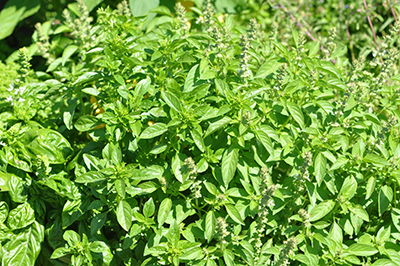Ocimum basilicum L. (Lamiaceae) var. citriodora


| ENG | Lemon basil |
| SK | bazalka citrónová |
| CZ | citronová bazalka |
| PL | bazylia cytrynowa |
| HU |
Using
The ingredients of the basil actively work at the gastrointestinal system, stimulate the secretion of gastric juice, increase appetite, accelerate absorption of nutrients. Essential oil acts antibacterial, antifungal, anti-inflammatory, immuno-modulating, antidiabetic and hipolipidemic, it can be used in cardiovascular and heart diseases, and as antioxidative agent. Basil is one of the most appreciated and most widely used spice plants.
| I. | II. | III. | IV. | V. | VI. | VII. | VIII. | IX. | X. | XI. | XII. | |||||||||||||
| Sowing | ||||||||||||||||||||||||
| Planting | ||||||||||||||||||||||||
| Harvest / Folium | ||||||||||||||||||||||||
| Harvest / Herba | ||||||||||||||||||||||||
Botanical description and occurrence:
Lemon basil is an annual herbaceous plant. It is a variety of Ocimum basilicum with lemon aroma and flavor, similar to that of Ocimum americanum and a hybrid species derived from O. basilicum x O. americanum, which are also called sometimes lemon basil. Lemon basil is low spreading plant (20-30 cm), with very compact growth habit. Leaves are small (3-5 cm) with light green color. Basil blooms in July and August. The predominant aroma components of lemon basil essential oil are: geranial, neral, E-caryophyllene, Z-??bisabolene, linalol, nerol. Herba Basilici ? leafy shoots, cut at the full bloom, and dried after the harvest (possible 2-3 harvests during one season).
Why to have the plant in your garden:
This basil cultivar has deliciously sweet lemon scented leaves. The flavor is incredible, not just for making a lemony pesto, but leaves can be added to salads, cookies, fruits, vinegars, fish specialties and teas.
Text:
Dr. Andrzej Kalisz, University of Agriculture in Krakow, Poland
Photo:
Dr. Ivana Mezeyova, SUA, Nitra, Slovak Republic
Links to scientific articles:
Hiltunen R., Holm Y., 2005. Basil. The Genus Ocimum. CRC Press.

